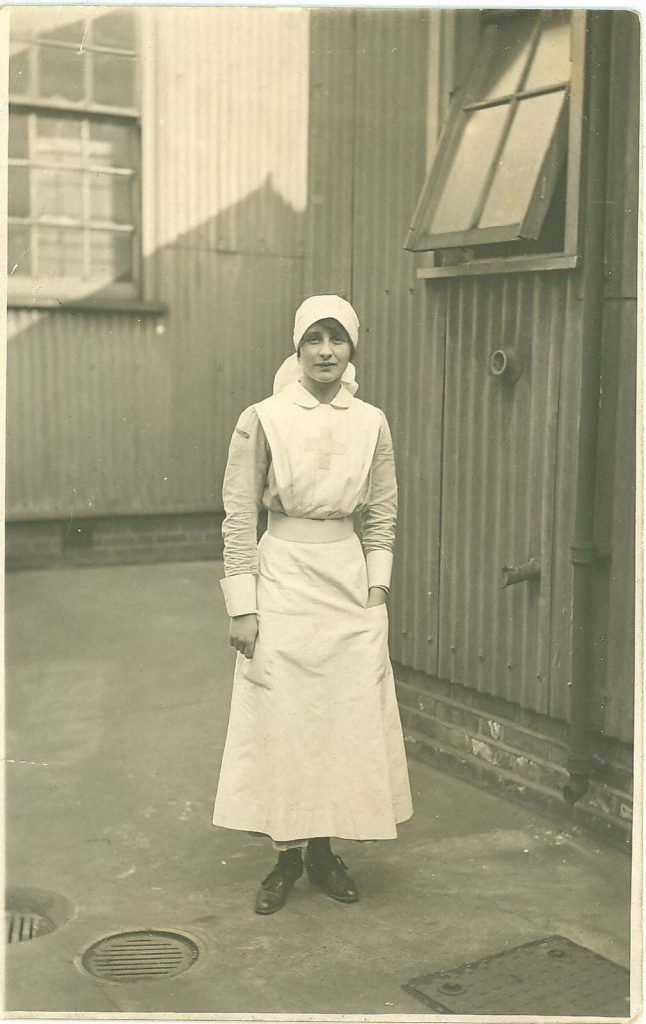This is a guest post by Naomi Coquillon, an education specialist in the Interpretive Programs Office. It is the second of two posts by Coquillon about films the Library is screening this summer to highlight European perspectives on World War I. The screenings are part of the Library’s commemoration of the centennial of U.S. involvement in the conflict.
Vera Brittain in the uniform of a World War I nurse with the Voluntary Aid Detachment. Photo courtesy First World War Poetry Digital Archive: http://ww1lit.nsms.ox.ac.uk/ww1lit/collections/item/1318.
This time last year He was seeing me off . . . and I had just begun to realise I loved Him. To-day he is lying in the military cemetery at Louvencourt—because a week ago He was killed in action. . . . And I, who in impatience felt a fortnight ago that I could not wait another minute to see him, must wait till all Eternity. All has been given to me, and all taken away again—in one year.
—Vera Brittain, New Year’s Eve, 1915
From “Chronicle of Youth: Vera Brittain’s War Diary”
In 1915, Vera Brittain—the daughter of a wealthy British paper manufacturer—suffered the first of many losses: her fiancé, Roland Leighton, was killed in action in the First World War just days before they were to be reunited for the Christmas holiday. That loss was followed in 1917 by those of her close friends Geoffrey Thurlow and Victor Richardson. Also in 1917, Brittain’s brother Edward was wounded in the Battle of the Somme; Brittain would nurse him back to health only to learn in June 1918 that he, too, had been killed in action. Roland, Geoffrey, Victor and Edward were among more than 700,000 soldiers from the United Kingdom to perish in the Great War. Through it all, Brittain recorded her thoughts and experiences in diaries, letters and poetry.
In 1915, Brittain wrote that “I am longing to begin nursing; the only way to support suffering one’s self is by alleviating even if it is only a little & indirectly, the sufferings of this unhappy stricken world.” Shortly thereafter, she left her studies at Oxford University to join the Voluntary Aid Detachment as a nurse, a role she would play for the remainder of the war. By 1918, more than 12,000 detachment nurses were serving in military hospitals throughout Europe.
After the war, Brittain returned to complete her studies at Oxford. She published her first novel, “The Dark Tide,” in 1923. It was followed 10 years later by “Testament of Youth,” her most famous work, which was based on her wartime diary and letters. In 2014, Brittain’s daughter, Baroness Shirley Williams, recalled that her mother “felt a need to recreate the young men that she loved by writing about them so their lives would not be ended. They’d live forever.”
“Testament of Youth” and Brittain’s personal correspondence present an unparalleled account of the World War I home front, battle front and aftermath of war. The novel was made into a BBC miniseries in 1979, nine years after Brittain’s death. In 2014, BBC Films produced a full-length feature starring Oscar-winner Alicia Vikander as Brittain and Kit Harington (now best known for his role in “Game of Thrones”) as Roland Leighton. At the premier of the film, Baroness Williams noted, “The great thing about this film is that in it, those young men do come alive again.” And through her letters and writings, Brittain does, too.
So it seems fitting that, as our summer series of European films on the Great War comes to an end, we should help to bring Brittain and her beloved brother and friends to life once again through Brittain’s story of that moment in time.
The Library will screen “Testament of Youth” at 2:30 pm on Saturday, August 12, in the Mary Pickford Theater, 3rd Floor, James Madison Building.
World War I Centennial, 2017–18. With the most comprehensive collection of multiformat World War I holdings in the nation, the Library of Congress is a unique resource for primary source materials, education plans, public programs and on-site visitor experiences about the Great War including exhibits, symposia and book talks.















